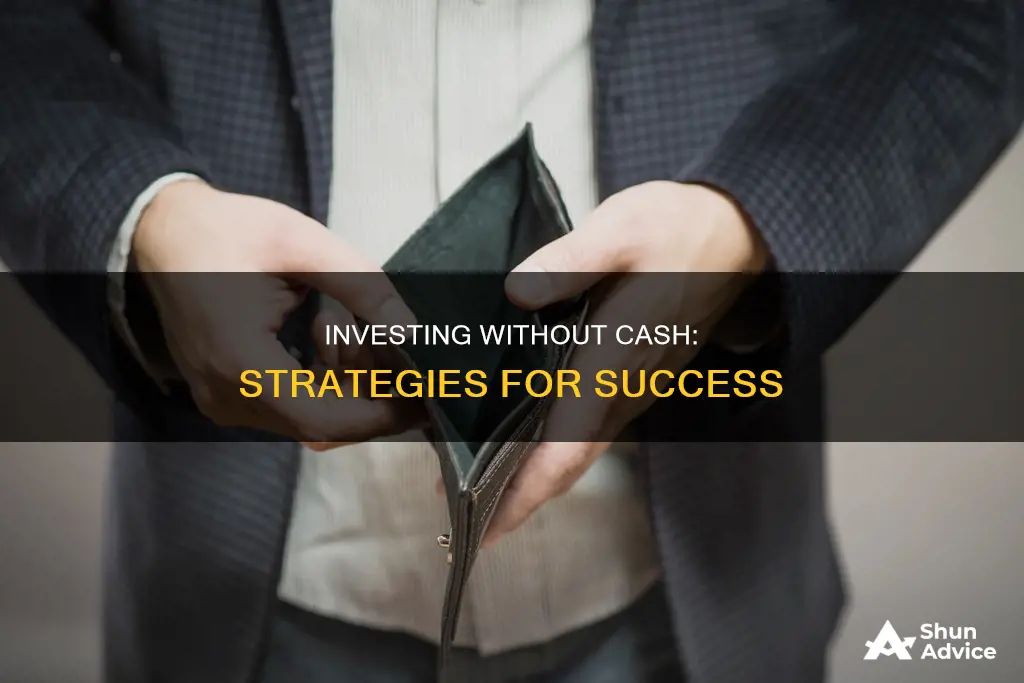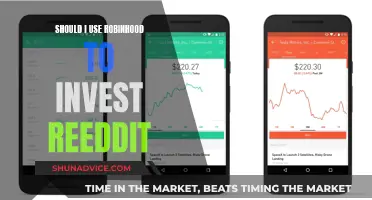
Investing is often associated with hedge funds and Wall Street brokers, but you don't need to be rich to start investing. It's a common misconception that you need a lot of money to be an effective investor, but this isn't true. You can start building a portfolio and growing your wealth with small amounts of money. One way to do this is by contributing to your employer's retirement plan, such as a 401(k), where a small amount of money can be diverted from your paycheck each time. You can also buy fractional shares, which means you can purchase a fraction of a share if you can't afford a full one. Micro-investing apps like Acorns allow you to invest your pocket change by rounding up purchases to the nearest dollar and depositing the difference into an investment account. Additionally, robo-advisors like Wealthfront and Betterment have low barriers to entry, with some requiring no account minimums. While it's important to consult a financial professional, there are many ways to start investing without a lot of cash.
What You'll Learn

Take advantage of your company's retirement plan
If you're looking to invest without cash, one of the best options is to take advantage of your company's retirement plan. Here's why:
Tax Benefits
Retirement plans offer significant tax advantages for both employers and employees. Contributions to employer-sponsored plans are often tax-deferred, reducing your annual taxable income by the amount you contribute. While distributions at retirement are taxed, it's likely you'll be in a lower tax bracket as a retiree. Additionally, employer contributions are tax-deductible, and assets in the plan grow tax-free.
"Free Money"
Many employers offer matching contribution programs, where they match a percentage of an employee's contribution. This essentially means you're leaving money on the table if you don't participate. For example, if your employer matches 50% of your contributions up to a certain percentage of your compensation, you could be missing out on hundreds or even thousands of dollars in "free money" each year.
Easy to Save
Retirement plans, such as 401(k)s, allow you to invest small amounts regularly. With each paycheck, a portion of your money can be automatically diverted into your retirement account. This makes it easy to save consistently without having to put aside large sums of money at once.
Long-Term Financial Security
Investing in a retirement plan is a way to secure your financial future. It ensures you have sufficient income for retirement and can provide peace of mind, knowing you're building a nest egg for your golden years.
Portability
Retirement plans are not always tied to a single employer. You can often carry your retirement assets with you when you change jobs, allowing you to continue growing your savings even as your employment situation changes.
Attractive Compensation Package
For employers, offering a retirement plan can be a valuable benefit that enhances the overall compensation package. It can help attract and retain talented employees, reduce training costs, and improve employee satisfaction and financial security.
Plan Flexibility
Retirement plans offer flexibility in terms of plan options, contribution amounts, and eligibility requirements. Employers can choose a plan that best suits their business needs and goals, and employees can contribute based on their financial capabilities.
In summary, taking advantage of your company's retirement plan is a great way to start investing without requiring a lot of cash upfront. It offers tax benefits, potential for growth with employer matching, and an easy way to save consistently for the future.
Fidelity Branches: Can You Deposit Cash?
You may want to see also

Buy fractional shares
Fractional shares allow you to invest small amounts in companies whose share prices are otherwise unaffordable. For example, if a company's share price is $100 and you only have $25, you can buy a quarter (25%) of a single share for $25. This makes it easier to diversify your portfolio by allowing you to trade small portions of an equities stock in various companies.
There are several brokers and platforms that allow you to buy fractional shares, including Stockpile, SoFi Active Trading, CommSec, Sharesies, Raiz, Stake, Interactive Brokers, and eToro. For example, Sharesies lets you invest as little as 1c in a fractional share of a company or exchange-traded fund (ETF) listed on the Australian, New Zealand, or US stock markets. Raiz lets you invest from $5 at a time in set portfolios that vary in risk levels.
When you buy fractional shares, you are typically not the registered owner of those shares. Instead, your fractional ownership is usually facilitated through a custody arrangement, where the broker is the registered owner of the whole share, and you, the investor, are the "beneficial owner", meaning your money and investments are held in trust for you by the legal owner. This has some downsides: you may not be able to transfer the shares to a different broker or into your name, and selling the shares may have tax implications.
Before investing in fractional shares, it's important to consider the fees and charges, as well as the risks. While fractional shares can be a low-cost way to start investing, you will only benefit from a fractional proportion of any price rise. Additionally, you may have to pay fees and charges related to your fractional share investments, which could eat away at your account if you only have a small amount to invest.
Corporations' Cash Investment Strategies: Unlocking Business Growth
You may want to see also

Use dividend reinvestment plans
Dividend reinvestment plans, also known as DRIPs, are a great way to invest without cash. They are a formal program offered by a publicly traded company to existing shareholders. They allow investors to reinvest their cash dividends into purchasing additional shares or fractional shares of the company's stock on the dividend payment date. This is a good strategy for those who don't have a lot of money to invest but want to start building a portfolio and growing their wealth.
DRIPs are a good option because they are flexible, easy to set up, and usually commission-free. They are flexible because they allow investors to buy fractional shares, which is something that brokers usually don't allow. They are easy because once they are set up, the reinvestment of dividends is automatic. And they are usually commission-free because there are no commissions or brokerage fees for the shares that are bought.
DRIPs are offered by many well-known companies, including GE, Coca-Cola, Verizon, Home Depot, and Johnson & Johnson. These companies allow investors to make regular purchases of very small amounts of stock and reinvest the dividends. This can add up to a big investment over time.
It's important to note that dividends paid into DRIPs are taxed even though they are used to purchase shares. And reinvesting dividends means you don't receive the cash from the dividend, which could be used for other purposes. However, DRIPs can be a great way to steadily grow wealth over time.
A Guide to Investing in Cash-Flow Websites
You may want to see also

Invest in an index fund
Index funds are a great way to invest without much money. Here's how you can get started:
Understand what an index fund is
Index funds are a group of stocks that mirror the performance of an existing stock market index, such as the Standard & Poor's 500 index. Index funds don't try to beat the market but aim to be the market by buying stocks of every firm listed on a market index. This makes them a passive management strategy, and they are often used to balance the risk in an investor's portfolio.
Know the benefits of index funds
- Low costs: Index funds are cheap to run because they are automated to follow shifts in value in an index.
- Better returns: Actively managed funds rarely beat the market, and even if they do, they rarely do so consistently over the long term. Passively managed index funds typically bring better returns over time.
- Diversification: Individual stocks may rise and fall, but indexes tend to rise over time. With index funds, you won't make bull returns during a bear market, but you also won't lose money if a single investment sinks.
- Tax efficiency: Index funds don't do as much buying and selling as actively managed funds, so they generate fewer capital gains that can add to your tax bill.
Choose the right fund for your index
There are hundreds of indexes you can track using index funds. The most popular index is the S&P 500, which includes 500 of the top US companies. Other popular indexes include the Dow Jones Industrial Average, the Nasdaq Composite, the Russell 2000, and the MSCI EAFE. You can also find sector indexes tied to specific industries, country indexes, and style indexes.
Decide where to buy your index funds
You can purchase an index fund directly from a mutual fund company or a brokerage. Exchange-traded funds (ETFs) are like mini mutual funds that trade like stocks throughout the day.
When choosing where to buy an index fund, consider fund selection, convenience, trading costs, impact investing, and commission-free options. For example, if you want to purchase index funds from various fund families, the big mutual fund companies may be a better option. On the other hand, if you require sophisticated stock research and screening tools, a discount broker might be a better choice.
Buy index fund shares
You can open a brokerage account to buy and sell shares of the index fund that interests you. Alternatively, you can open an account directly with a mutual fund company that offers the index fund you want.
Look at costs and features when deciding how to buy shares of your index fund. Some brokers charge extra for customers to buy index fund shares, so it may be cheaper to go directly through the index fund company. However, many investors prefer to have all their investments held in a single brokerage account.
Keep an eye on your index funds
While index funds are passive management strategies, you should still monitor their performance. Check that your index fund is mirroring the performance of the underlying index. Also, watch out for fees that stack up over time, and consider switching to a cheaper index fund if that happens.
Maximizing Cash Value Life Insurance: A Smart Investment Guide
You may want to see also

Diversify with an ETF
Exchange-traded funds (ETFs) are financial products that track the performance of a certain sector of the investment market. They are a great way to diversify your portfolio without much cash. You can buy as little as one share of an ETF through a broker, and some of these ETFs track the performance of the total stock market, the bond market, and many others.
ETFs are a great way to gain exposure to a diversified portfolio. For example, the Vanguard Total Stock Market ETF (VTI) will bring exposure to an instantly diversified portfolio that also pays a dividend.
Diversification through ETFs can help investors reduce risk without significantly impacting expected returns. A diversified portfolio should span various asset classes, such as stocks for growth, bonds for stability, commodities for inflation, and cash for security.
One example of an ETF is the iShares Core Moderate Allocation ETF (AOM). This ETF uses a "fund of funds" structure to encompass multiple other iShares ETFs, giving it a fairly conservative split of 40% in global equities and 60% in global fixed income. The ETF is professionally managed and periodically rebalanced back to this target allocation. AOM charges a 0.15% expense ratio.
Another example is the Vanguard Total World Stock ETF (VT). This ETF tracks the FTSE Global All Cap Index, which currently holds over 9,900 U.S., international developed, and emerging market equities for an affordable 0.07% expense ratio.
It's important to note that ETFs are not without risks. They carry the risk of loss, and past performance is not a guarantee of future results. Additionally, ETFs may have higher minimums and/or fees than traditional mutual funds.
Understanding Cash Flows from Investing Activities
You may want to see also
Frequently asked questions
It is possible to start investing with a small amount of money. You can start by contributing to your employer's retirement plan, buying fractional shares, using dividend reinvestment plans, or micro-investing.
A dividend reinvestment plan, commonly referred to as DRIP, allows you to buy shares of a dividend-yielding stock or fund, and automatically reinvest any dividends received to purchase more shares.
Micro-investing allows you to invest small amounts of money repeatedly to build your portfolio. For example, you can use an app like Acorns, which rounds up your transactions to the nearest dollar and invests the difference.
It is important to understand the core principles of investing, such as what stocks and bonds are, how fees can impact your returns, and how much risk you can tolerate. You should also be aware of the difference between investing and gambling—investing in the stock market is not the same as buying a lottery ticket because it is based on historical data and performance.







